Latvia & Vilnius, Lithuania Day 11-13
Day 11 Monday Sigulda, Latvia to Lithuania:
Today went a little different than expected. We had planned to go back to Cēsis to spend a little more time but instead we went on to Sigulda. This town is known for its natural beauty, its extreme sports and the most visited “museum” in Latvia. They had a cable car ride that I really wanted to go on. Mike wasn’t quite as enthusiastic. I had emailed Gabriel in Vilnius and told him that we would meet him for lunch on Tuesday. I had planned on having lunch on Monday in Vilnius but we got too far behind. Normally we go really slow at the beginning of one of these vacations and then have to rush at the end. With this trip, knowing that I did’t want to give up any of the 3 capital cities or a few other places, it has caused some rushing at other points in time. For example, today we spent quite a while wandering around the main castle and its grounds in Sigulda. This is now considered a museum and different parts of the property have different things to see. Having committed to lunch tomorrow in Vilnius which is about a 4 hour drive away we had to skip the cable car and we made our longest drive so far. The car started doing its hiccupping again which still worries me. There is just too much to see in two weeks. It really hasn’t made much difference if we stay in the fancy campgrounds with all sorts of amenities or if we stay in the ones that are basically a parking lot with some services. We get there late in the day and leave the next morning. It would be nice to take advantage of some of the amenities and nature walks. Some of them have row boats and canoes available, that kind of thing. It is more important to me though to see these capital cities and their old towns than to go for a canoe ride and have to give up one of the cities. I love what I am seeing but I can’t say that I find it extremely relaxing.
Day 12 &13 Tuesday/Wednesday Vilnius, Lithuania
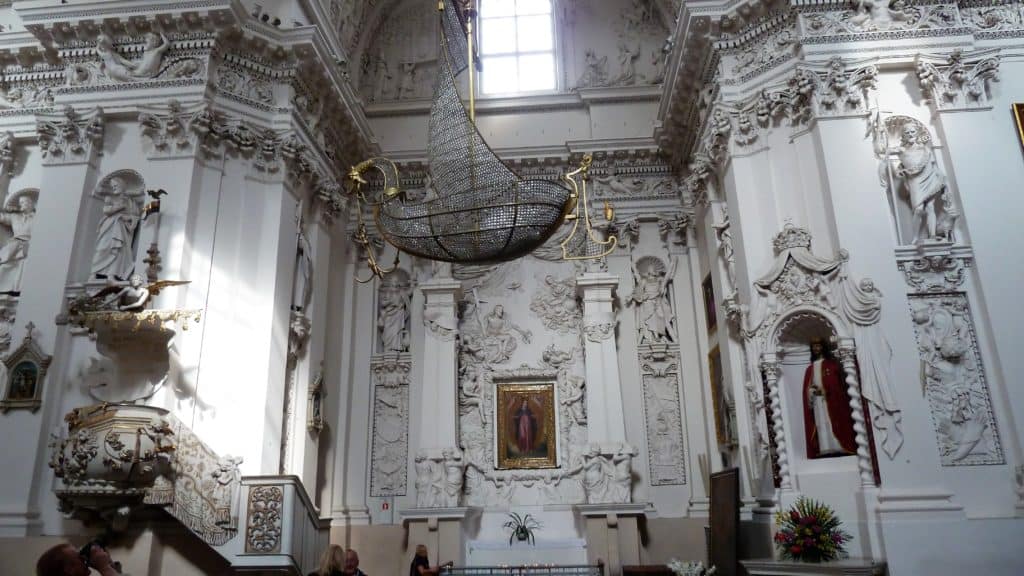
I am writing this part just as we have left Vilnius. It should be called the city of churches. It has more churches than you can believe and they are so different from each other. We initially went into a lovely Jesuit Orthodox church that was fairly ornate. The designs and artwork were great. We then went into another church and my first reaction was of stereotype Italian design gone wild. The ornateness was actually overwhelming. Today we went into a 17th century baroque church called Sts. Peter & Pauls’ Church. The plaster work in this church was absolutely, unbelievably over the top. It seemed like there wasn’t a spot in the church that didn’t have either some artwork, or more likely, plaster carvings. It wasn’t like the plaster or stucco was just flowers, it was phenomenal. There were large statures and tiny statues, scenes and stories, faces hidden in designs and some flowers. It was way too much but at the same time the individual pieces were excellent. 98% of the plaster was plain white with the occasional gold gilded piece in the middle of a statue or scene. The altar in Sts. Peter & Pauls’ Church was very plain. There was a crystal boat hanging from the ceiling which you can see in the picture. Apparently a very ornate altar, in keeping with the rest of the church, had been carved in Italy and was being sent to Vilnius via ship when the ship sank. Instead of replacing the altar they created this hanging boat in the church basically as a memorial. The Church of St. Anne looked quite different from the others on the outside in that it was all red brick. Mike’s comment on this very lovely looking church was “who would have thought you could do that with just red brick”.
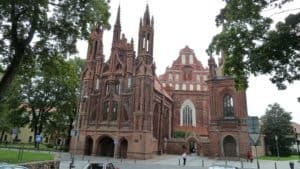
There are so many churches that there are churches attached to churches. I this picture the Church of St. Anne is in the front and the Bernadine Church is attached in the back. We wandered through parts of the university, again the outside was more impressive than the inside. It was interesting to note both at the university here and in Tartu, the students look like students anywhere including the occasional ones with red or blue or orange hair and some with weird clothes. I think both Vilnius and Tartu claim to have the oldest university in the Baltics. All of the cities that we have seen so far appear to have lots of parks, bike trails, walking trails, and water elements, lots of green. It is very nice.
We didn’t just see churches in Vilnius, we also toured a few castles. One was at the top of a hill with funicular access – very civilized. We walked up to the top of the tower and had a lovely view looking down on Vilnius. One side of the river is the older more historic area and the other side of the river is the new business district. On Tuesday night Gabriel took us to a castle complex about ½ hour drive outside Vilnius in Trakai. We go there 30 minutes before closing so as we toured the various rooms that had been turned into “museum” or display areas there was someone coming right behind us turning off lights and closing doors. It does tend to make you speed up. There had been a huge restoration done of the castle and property and pretty well all of it had been done during the Soviet era. We then ate dinner in the in a lovely restaurant overlooking the lake and castle. Gabriel wanted us to try some traditional foods. One dish that Gabriel insisted could only be found in Lithuania was very much like shepherd’s pie except that the potatoes were wrapped around the beef instead of just on the top.
I have been drinking cappuccinos across the Baltics, mainly because I didn’t know what else to order. There is a huge variety in what you get when you order a cappuccino. Last night I had a lovely one in a tall glass with a reasonable amount of foam, this morning I had one the size of an espresso coffee. Sometimes I need sugar and sometimes I don’t. You won’t believe where I found my most consistent and nice cappuccinos recently – McCafé – attached to McDonalds. There aren’t as many McDonald’s here as there are in Canada but you do see them. Mike and I had basically ignored them until a few days ago. I was pleasantly surprised with their coffee. The McCafé and the main McDonald’s counter may be in the same building but they are treated much more separately than they are at home. The girls making the coffee all do a wonderful job of making little chocolate designs on top of the foam. At first I thought that they were taught one design to do but I was wrong. They make different designs for everybody. It looks very nice.
The old town of Vilnius was quite different from Riga and Tallinn. For one thing, cars were allowed on almost all the streets, even the narrow ones. This gives the area both a more commercial air and more of an impression of people living there. Mike says it looks more affluent but I don’t know that I agree. The architecture is still lovely and you have the cobblestone streets and the Parisian type buildings with hidden courtyards behind them. It is really lovely to wander through. We peeked in the courtyards of a couple of private dwellings and they had done some lovely things with them. It was interesting to me that in one of them they had actually fenced off (low decorative fence) separate backyards for the housing backing onto the courtyard. The courtyard also contained garages for the homes. The main street just outside the old town has buildings that look like store fronts on the ground level and then the lovely pastel colours and interesting architecture at higher levels. The main street is 2 km long with a Roman Catholic church at one end and an Eastern Orthodox at the other. Along the way the street connects 4 squares including Cathedral Square and Freedom Square. I don’t remember the other two. What I do remember is that this street gets renamed every time the country gets occupied. It has been called Kaiser and Hitler streets during various German occupations. It has been named after Stalin and Lenin and at least one other Soviet name and it is now called something to do with Lithuania’s freedom or independence.
Lithuania has a much more significant past as an entity than the other Baltics nations do, or so it seems to me. In the 15th century Lithuania stretched from the Baltic Sea to the Black Sea, had a king at one point and was a fairly significant power. I don’t believe that this was true about either of the other countries.
There is a green bridge going across a river in Vilnius that has a statue at each corner. These statues are each about 10 feet high and are one of the very few remaining symbols from the Soviet era. They are considered prominent examples of Soviet realism representing the four major social classes: soldiers, workers, farmers and students. Each statue consists of two very life like people. The statues apparently need some repair. I saw in a local newspaper that they have just gone out to bid for the repairs and some politicians don’t want to spend any money on soviet statues. They would rather tear them down. I think that this time period was part of their history and the statues should be retained. Something else interesting from their history is that pre WWII there were about 220,000 Lithuanian Jews in Vilnius, a reasonable percentage of the population. During the German occupation more than 200,000 were killed. Basically every Jew who remained in Vilnius died. The worst part of this is that the Germans killed the Jews in conjunction with local Lithuanians. The Germans planted information about the Jews being communist and helping the Soviets and really stirred up anti-semitic hatred, who knows how much was there to start with as well. Not a good story and one that you don’t hear anything about as you travel around Lithuania. There are even some memorials to the Jewish who died in Vilnius. I gather that the Lithuanians just want to gloss over any part that they had in those terrible and almost unbelievable numbers.
There is an interesting mix of English and Lithuanian on some of the signs you see. One restaurant is called Steak House Restoranas. The name starts in English and ends in Lithuanian.
They use smart phones for a lot more here than we do. I think I told you that in Tallinn they identified themselves on their smart phone app and then paid the parking for a specific license plate number. In Vilnius they have stickers on their car and you send a text message referencing your sticker and pay for parking that way. It appears that in Lithuania just are just supposed to know that you need to pay. In some areas Mike and I didn’t see any signs to pay for parking and there were no machines but you were supposed to know to pay electronically. All we can do is keep our fingers crossed that we don’t inadvertently get a ticket.
Vilnius has a program similar to one Toronto has been talking about where you have bicycles around the city for people to rent from one place and return later, possibly somewhere else. Vilnius tried this a few years ago and all the bikes went missing (stolen) after a while. This time they have done it a bit differently and it makes great sense to me. They do a serious authorization check before you can borrow bicycles. The city assumes that you can get to most places in a half hour and they price the bicycles accordingly. First 30 minute rental – FREE, next 30 minutes – 60 cents, next 30 minutes – $2.00, next 30 minutes – $4.80 and it keeps going up from there. The intent is not to take a bike in the morning and return it that night. The intent is to use it to get where you want to go instead of using a car. When you get there put the bike in one of the special bike racks and get another one if you need it later in the day. It makes a lot of sense to me.
A couple of miscellaneous things that we have observed. While driving this afternoon we noticed lanes that said that they were 4+ people (not 2) or taxis or electric cars. Another thing, no-one here will ever hand you money directly. Every cash register has a little tray next to it where your change is always put. I am not sure if you are supposed to put your money there when you pay but they haven’t been refusing to take it from my hand, they just won’t put the change back in my hand. Latvia switches to the Euro next year but in the one or two places that we tried to use a Euro they flatly refused. Lithuania doesn’t switch to the Euro for a couple of years but in many places they will actually give you the price in both Litas and Euros. The roads in Lithuania have many permanent, fixed speed cameras. Gabriel says that they aren’t always all working. He said that you get a ticket if you are doing a certain amount over the limit and that amount is different for city and highway driving. This little GPS mapping program that I bought for my phone actually has these speed cameras marked and it warns you about them and turns the screen all pink in case you weren’t listening. This is one of the best little apps I have ever purchased. It cost about $8.00 for worldwide coverage. You could buy a single country for a dollar or two. I bought it because it lets you download the maps so that you don’t need internet access. I wasn’t expecting a lot for Estonia, Latvia, and Lithuania, was I wrong. It not only has ALL the roads marked but it marked the one way lanes in the shopping plaza that we went in to get some groceries. It knows about the speed cameras and every so often tells Mike to watch his speed. It is excellent. I have bought many $1 and $2 apps that were money wasted but something like this sure makes up for it.
We are staying in a campground tonight that I am not happy with. First off, it is very high priced for an off season campground but it was too late to go on to the next one which wasn’t very far away. When we checked in the sign said free wifi. It turns out that their wifi only reaches 50 ft from the office and there are no campsites or electricity within 50 ft. So yes, technically there is free wifi on the grounds but not a single camper has access from their RV to it. This really annoyed me. Now I am sitting here typing this and listening to a train go by about every 10 minutes. Some are quiet, some are long and noisier and some use their whistle. I am really not happy with this place and the longer it takes to write this the more annoyed I get with the trains.
I have one other thing that I would like to write about but I am thinking of doing it in a completely separate note. I talked briefly in an earlier note about the reaction of some of the people to communism. Now I don’t have a huge sampling but I do have some impressions that are a little different from what we hear in the west. I would like to put what I heard in a note and if it is something you aren’t interested in you can easily skip the whole note.
One place in Lithuania that is very famous is a 50 km long sand dune or spit of land. Mike and I had originally decided to give it a pass. Yesterday Gabriel basically insisted that if we went nowhere else we had to go to this town called Nida at the end of the spit with the Baltic Sea on one side and the inland water on the other. It means a little more driving but Mike doesn’t mind that so we are off to see sand dunes tomorrow.
That train is going to drive me nuts.
Bye for now.

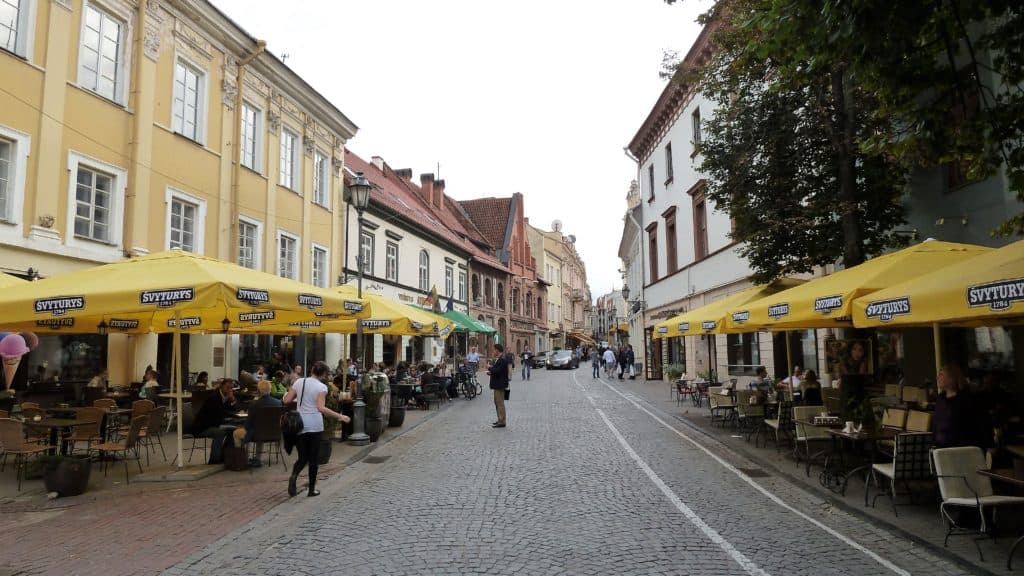
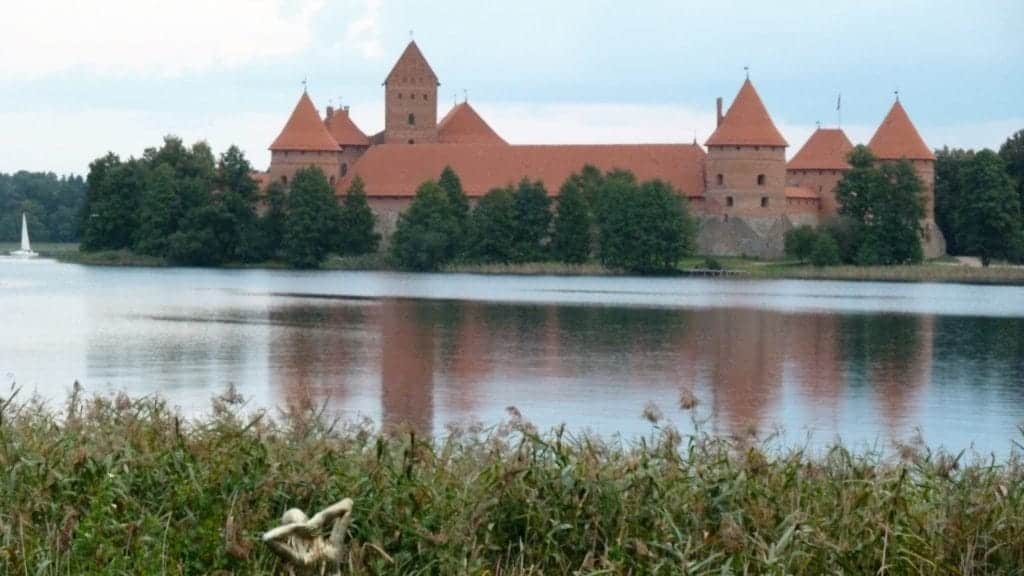
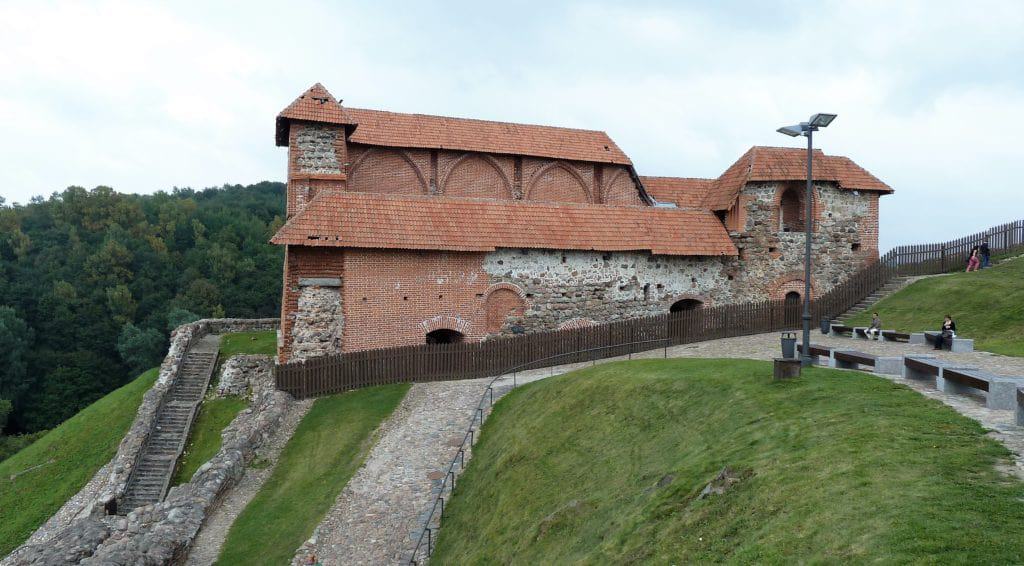
Leave a Reply